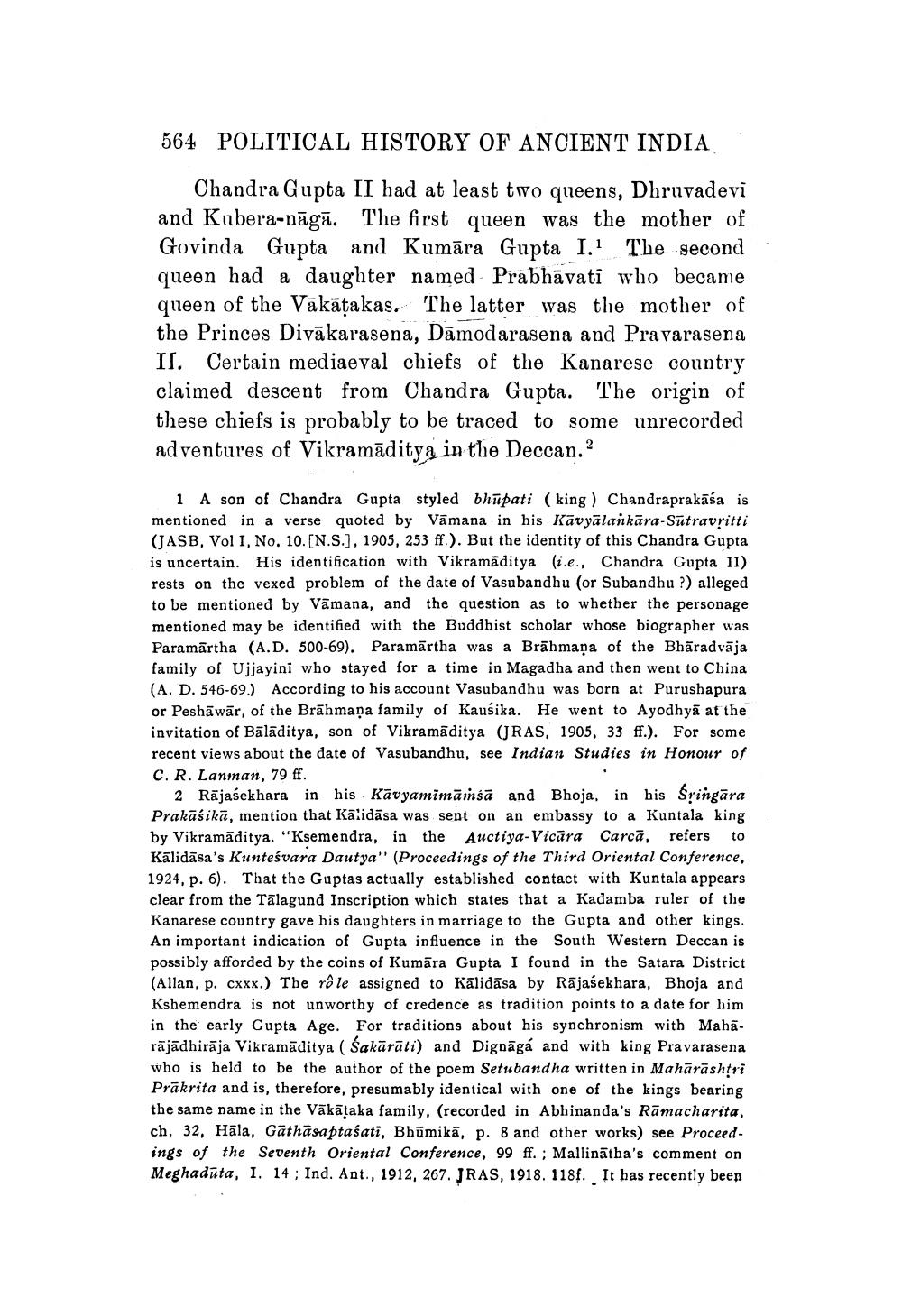________________
564 POLITICAL HISTORY OF ANCIENT INDIA
Chandra Gupta II had at least two queens, Dhruvadevi and Kubera-nāgā. The first queen was the mother of Govinda Gupta and Kumāra Gupta I.1 The second queen had a daughter named Prabhāvati who became queen of the Vākāțakas. The latter was the mother of the Princes Divākarasena, Dāmodarasena and Pravarasena II. Certain mediaeval chiefs of the Kanarese country claimed descent from Chandra Gupta. The origin of these chiefs is probably to be traced to some unrecorded adventures of Vikramāditya in the Deccan.
1 A son of Chandra Gupta styled bhupati (king) Chandraprakasa is mentioned in a verse quoted by Vāmana in his Kāvyālankāra-Sūtravritti (JASB, Vol I, No. 10.[N.S.), 1905, 253 ff.). But the identity of this Chandra Gupta is uncertain. His identification with Vikramaditya (i.e., Chandra Gupta II) rests on the vexed problem of the date of Vasubandhu (or Subandhu ?) alleged to be mentioned by Vāmana, and the question as to whether the personage mentioned may be identified with the Buddhist scholar whose biographer was Paramartha (A.D. 500-69). Paramārtha was a Brāhmaṇa of the Bhāradvāja family of Ujjayini who stayed for a time in Magadha and then went to China (A. D. 546-69.) According to his account Vasubandhu was born at Purushapura or Peshāwār, of the Brāhmana family of Kausika. He went to Ayodhyā at the invitation of Bālāditya, son of Vikramaditya (JRAS, 1905, 33 ff.). For some recent views about the date of Vasubandhu, see Indian Studies in Honour of C.R. Lanman, 79 ff.
2 Rajasekhara in his Kāvyamimāmsā and Bhoja, in his Sringāra Prakāśikā, mention that Kalidāsa was sent on an embassy to a Kuntala king by Vikramāditya. "Ksemendra, in the Auctiya-Vicāra Carcā, refers to Kālidāsa's Kunteśvara Dautya" (Proceedings of the Third Oriental Conference, 1924, p. 6). That the Guptas actually established contact with Kuntala appears clear from the Tālagund Inscription which states that a Kadamba ruler of the Kanarese country gave his daughters in marriage to the Gupta and other kings. An important indication of Gupta influence in the South Western Deccan is possibly afforded by the coins of Kumāra Gupta I found in the Satara District (Allan, p. cxxx.) The rôle assigned to Kālidāsa by Rājasekhara, Bhoja and Kshemendra is not unworthy of credence as tradition points to a date for him in the early Gupta Age. For traditions about his synchronism with Mahārājādhirāja Vikramāditya ( Sakārāti) and Digoāga and with king Pravarasena who is held to be the author of the poem Setubandha written in Mahārāshtri Prākrita and is, therefore, presumably identical with one of the kings bearing the same name in the Vākātaka family. (recorded in Abhinanda's Rāmacharita, ch. 32, Hāla, Gāthāsaptaśati, Bhūmikā, p. 8 and other works) see Proceedings of the Seventh Oriental Conference, 99 ff.; Mallinātha's comment on Meghaduta, I. 14; Ind. Ant., 1912, 267. JRAS, 1918. 118f. It has recently been




